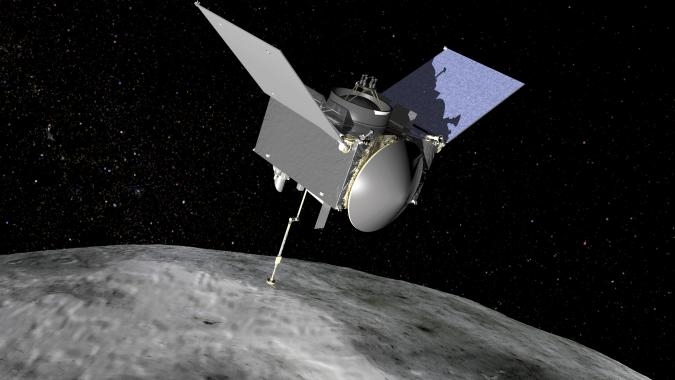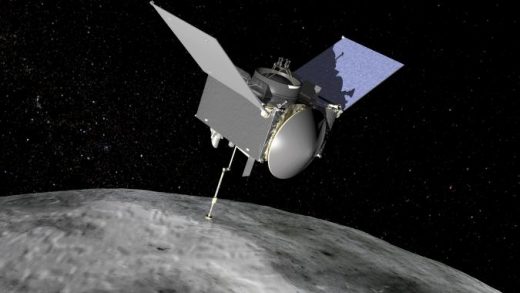Asteroid NASA’s OSIRIS-REx mission landed on had a surface like a ‘pit of plastic balls’
NASA’s OSIRIS-REx successfully collected bits of an orbiting asteroid
Now it has a three-year trek across the solar system to get back to Earth.


NASA made history on Tuesday afternoon as its OSIRIS-REx spacecraft successfully “tagged” the asteroid 101955 Bennu, and in doing so collected a small sample of regolith from the passing celestial body’s surface. This marks the first time that a NASA mission has managed to intercept, interact with and collect samples from an asteroid.
This is far from the first time that humanity has brought a piece of the stars back with us when returning from space. We’ve been doing it pretty regularly since the Apollo moon missions, in fact. The Mir Space Station hung pieces of aerogel on the station exterior for 18 months to collect samples of low earth orbit space debris back in 1996. In 2004, the Genesis mission returned solar wind samples, the first ever collected from beyond lunar orbit, despite fumbling its atmospheric reentry and crash landing.
2006 saw the return of the Stardust spacecraft, which had successfully collected the first samples from a passing comet. And in 2014, only two years before OSIRIS-REx launched, JAXA’s Hayabusa2 space probe set off for a similar meetup with asteroid 162173 Ryugu. It arrived at the asteroid in 2018, hung around for a year doing surveys before scooping up a container of regolith — bits of rock and dust — and jetting off back to Earth. It’s expected to arrive on December 6th.
The $800 million OSIRIS-REx (Origins, Spectral Interpretation, Resource Identification, Security, Regolith Explorer) mission is being led by Dante Lauretta, Professor of Planetary Science and Cosmochemistry at the University of Arizona’s Lunar and Planetary Laboratory and aims to further our understanding of how the early Solar System formed.
Class-B asteroids like Bennu serve as time capsules of a sort. “Asteroids are leftovers formed from the cloud of gas and dust — the solar nebula — that collapsed to form our sun and the planets about 4.5 billion years ago,” NASA’s Dwayne Brown wrote in 2011. “As such, they contain the original material from the solar nebula, which can tell us about the conditions of our solar system’s birth.”
Additionally, they’re rich in both carbon and volatile compounds which could help us figure out how life started — or if an atmosphere is even required for life to get going seeing as how we’ve previously found amino acids and other organic compounds on the surfaces of asteroids.
OSIRIS took off from Cape Canaveral, Florida in September 2016. It arrived at Bennu in 2018 and, like the Hyabusa2 mission before it, has spent the last two years surveying and studying the skyscraper-sized asteroid. Those surveys have revealed that organic carbonaceous material is spread widely over Bennu’s surface, especially at the Nightingale site where OSIRIS set down.
“The abundance of carbon-bearing material is a major scientific triumph for the mission. We are now optimistic that we will collect and return a sample with organic material – a central goal of the OSIRIS-REx mission,” Lauretta explained
The team also found carbonate minerals during the survey, suggesting the Bennu was once part of an even larger asteroid, one with an hydrothermal system where liquid water interacted with the rock. What’s more, the regolith found at Nightingale appears to have only ever been exposed to a space-based environment, meaning that the roughly two ounces of collected samples will be especially pristine and unsullied by biological contaminants.
Collecting those samples involved a never-before-tried technique dubbed the touch-and-go (TAG). Before beginning its approach, the OSIRIS unfolded and deployed its Touch-And-Go Sample Acquisition Mechanism (TAGSAM) while pulling its solar panels back into a Y-shape so that if the TAGSAM arm did accidentally overshoot and crunch into Bennu, the rest of the spacecraft would still have the necessary power to function. Given that NASA was trying to set a spacecraft the size of a minivan down in an area the size of a few parking spaces — that just so happened to be surrounded by house-sized boulders — keeping all of OSIRIS’ bits and pieces out of the way was of paramount importance.
OSIRIS was only in physical contact with the asteroid for a few seconds — just long enough to emit a puff of nitrogen gas that lifted bits of regolith off of Bennu’s surface for collection. To ensure that it has a sufficiently large sample, OSIRIS will first take a picture of the collector head to confirm the presence of regolith, and then on Saturday will extend its TAGSAM arm and spin on its axis like a centrifuge to measure the mass of rock and dust in the collection bin. From here, OSIRIS-Rex will pull away from the asteroid, redeploy its solar panels as well as a high-gain antenna to transmit initial images and data from the operation then begin a nearly three year long trek back to Earth where the collection capsule is expected to land at the Utah Test and Training Range in 2023.
“After over a decade of planning, the team is overjoyed at the success of today’s sampling attempt,” said Lauretta said during a post-maneuver press conference. “Even though we have some work ahead of us to determine the outcome of the event. The successful contact, the TAGSAM gas firing, and back-away from Bennu are major accomplishments for the team. I look forward to analyzing the data to determine the mass of sample collected.”
(12)


